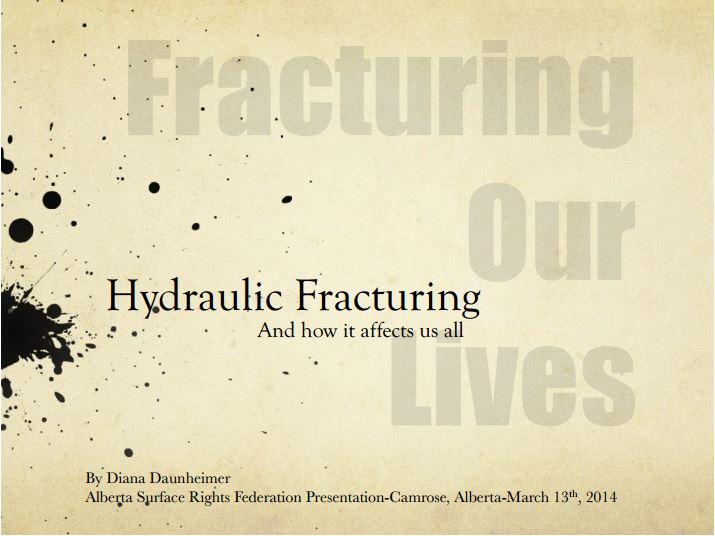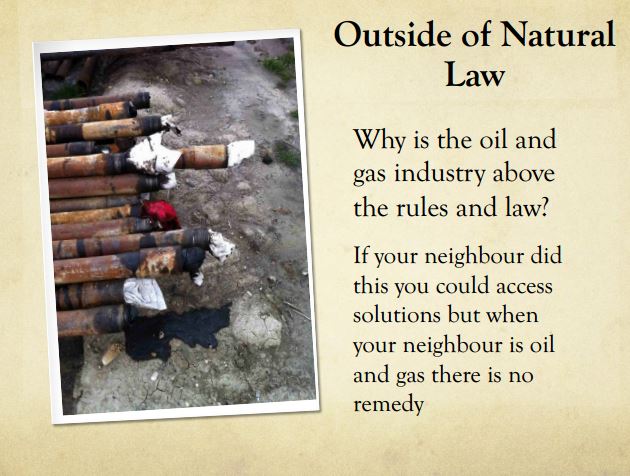Holy shit, that’s hair-raising reading. Appalling! Horrifying! Slowly kill unsuspecting workers and residents, “generously” donate old pipes for kids’ playgrounds, irreparably pollute waterways, … all to maximize profits. Money trumps people, every single time. The CEOs and top administrators of all these companies should be forced to have brine enemas at least once a week. And brew their coffee or tea with frack waste water.
Above comment from a reader in British Columbia.
America’s Radioactive Secret, Oil-and-gas wells produce nearly a trillion gallons of toxic waste a year. An investigation shows how it could be making workers sick and contaminating communities across America by JUSTIN NOBEL , Jan 21, 2020, Rolling Stone Magazine
Justin Nobel is writing a book about oil-and-gas radioactivity for Simon & Schuster. This story was supported by the journalism nonprofit Economic Hardship Reporting Project
In 2014, a muscular, middle-aged Ohio man named Peter took a job trucking waste for the oil-and-gas industry. The hours were long — he was out the door by 3 a.m. every morning and not home until well after dark — but the steady $16-an-hour pay was appealing, says Peter, who asked to use a pseudonym. “This is a poverty area,” he says of his home in the state’s rural southeast corner. “Throw a little money at us and by God we’ll jump and take it.”
In a squat rig fitted with a 5,000-gallon tank, Peter crisscrosses the expanse of farms and woods near the Ohio/West Virginia/Pennsylvania border, the heart of a region that produces close to one-third of America’s natural gas. He hauls a salty substance called “brine,” a naturally occurring waste product that gushes out of America’s oil-and-gas wells to the tune of nearly 1 trillion gallons a year, enough to flood Manhattan, almost shin-high, every single day. At most wells, far more brine is produced than oil or gas, as much as 10 times more. It collects in tanks, and like an oil-and-gas garbage man, Peter picks it up and hauls it off to treatment plants or injection wells, where it’s disposed of by being shot back into the earth.
One day in 2017, Peter pulled up to an injection well in Cambridge, Ohio. A worker walked around his truck with a hand-held radiation detector, he says, and told him he was carrying one of the “hottest loads” he’d ever seen. It was the first time Peter had heard any mention of the brine being radioactive.
The Earth’s crust is in fact peppered with radioactive elements that concentrate deep underground in oil-and-gas-bearing layers. This radioactivity is often pulled to the surface when oil and gas is extracted — carried largely in the brine.
In the popular imagination, radioactivity conjures images of nuclear meltdowns, but radiation is emitted from many common natural substances, usually presenting a fairly minor risk. Many industry representatives like to say the radioactivity in brine is so insignificant as to be on par with what would be found in a banana or a granite countertop, so when Peter demanded his supervisor tell him what he was being exposed to, his concerns were brushed off; the liquid in his truck was no more radioactive than “any room of your home,” he was told. But Peter wasn’t so sure.
“A lot of guys are coming up with cancer, or sores and skin lesions that take months to heal,” he says. Peter experiences regular headaches and nausea, numbness in his fingertips and face, and “joint pain like fire.”
He says he wasn’t given any safety instructions on radioactivity, and while he is required to wear steel-toe boots, safety glasses, a hard hat, and clothes with a flash-resistant coating, he isn’t required to wear a respirator or a dosimeter to measure his radioactivity exposure — and the rest of the uniform hardly offers protection from brine.
“It’s all over your hands, and inside your boots, and on the cuticles of your toes, and any cuts you have — you’re soaked,” he says.
So Peter started quietly taking samples of the brine he hauled, filling up old antifreeze containers or soda bottles. Eventually, he packed a shed in his backyard with more than 40 samples. He worried about further contamination but says, for him, “the damage is already done.” He wanted answers. “I cover my ass,” he says. “Ten or 15 years down the road, if I get sick, I want to be able to prove this.”
Through a grassroots network of Ohio activists, Peter was able to transfer 11 samples of brine to the Center for Environmental Research and Education at Duquesne University, which had them tested in a lab at the University of Pittsburgh. The results were striking.
Radium, typically the most abundant radionuclide in brine, is often measured in picocuries per liter of substance and is so dangerous it’s subject to tight restrictions even at hazardous-waste sites. The most common isotopes are radium-226 and radium-228, and the Nuclear Regulatory Commission requires industrial discharges to remain below 60 for each.
Four of Peter’s samples registered combined radium levels above 3,500, and one was more than 8,500.
“It’s ridiculous that these drivers are not being told what’s in their trucks,” says John Stolz, Duquesne’s environmental-center director. “And this stuff is on every corner — it is in neighborhoods. Truckers don’t know they’re being exposed to radioactive waste, nor are they being provided with protective clothing.
“Breathing in this stuff and ingesting it are the worst types of exposure,” Stolz continues. “You are irradiating your tissues from the inside out.” The radioactive particles fired off by radium can be blocked by the skin, but radium readily attaches to dust, making it easy to accidentally inhale or ingest. Once inside the body, its insidious effects accumulate with each exposure. It is known as a “bone seeker” because it can be incorporated into the skeleton and cause bone cancers called sarcomas. It also decays into a series of other radioactive elements, called “daughters.” The first one for radium-226 is radon, a radioactive gas and the second-leading cause of lung cancer in the U.S. Radon has also been linked to chronic lymphocytic leukemia. “Every exposure results in an increased risk,” says Ian Fairlie, a British radiation biologist. “Think of it like these guys have been given negative lottery tickets, and somewhere down the line their number will come up and they will die.”
Peter’s samples are just a drop in the bucket. Oil fields across the country — from the Bakken in North Dakota to the Permian in Texas — have been found to produce brine that is highly radioactive. “All oil-field workers,” says Fairlie, “are radiation workers.” But they don’t necessarily know it.
Tanks, filters, pumps, pipes, hoses, and trucks that brine touches can all become contaminated, with the radium building up into hardened “scale,” concentrating to as high as 400,000 picocuries per gram.
With fracking — which involves sending pressurized fluid deep underground to break up layers of shale — there is dirt and shattered rock, called drill cuttings, that can also be radioactive. But brine can be radioactive whether it comes from a fracked or conventional well; the levels vary depending on the geological formation, not drilling method.
Colorado and Wyoming seem to have lower radioactive signatures, while the Marcellus shale, underlying Ohio, Pennsylvania, West Virginia, and New York, has tested the highest. Radium in its brine can average around 9,300 picocuries per liter, but has been recorded as high as 28,500.
“If I had a beaker of that on my desk and accidentally dropped it on the floor, they would shut the place down,” says Yuri Gorby, a microbiologist who spent 15 years studying radioactivity with the Department of Energy. “And if I dumped it down the sink, I could go to jail.”
The advent of the fracking boom in the early 2000s expanded the danger, saddling the industry with an even larger tidal wave of waste to dispose of, and creating new exposure risks as drilling moved into people’s backyards.
“In the old days, wells weren’t really close to population centers. Now, there is no separation,” says City University of New York public-health expert Elizabeth Geltman. In the eastern U.S. “we are seeing astronomically more wells going up,” she says, “and we can drill closer to populations because regulations allow it.” As of 2016, fracking accounted for more than two-thirds of all new U.S. wells, according to the Energy Information Administration. There are about 1 million active oil-and-gas wells, across 33 states, with some of the biggest growth happening in the most radioactive formation — the Marcellus. And some regulations have only gotten weaker.
“Legislators have laid out a careful set of exemptions that allow this industry to exist,” says Teresa Mills of the Buckeye Environmental Network, an Ohio community-organizing group. “There is no protection for citizens at all — nothing.”
In an investigation involving hundreds of interviews with scientists, environmentalists, regulators, and workers, Rolling Stone found a sweeping arc of contamination — oil-and-gas waste spilled, spread, and dumped across America, posing under-studied risks to the environment, the public, and especially the industry’s own employees. There is little public awareness of this enormous waste stream, the disposal of which could present dangers at every step — from being transported along America’s highways in unmarked trucks; handled by workers who are often misinformed and underprotected; leaked into waterways; and stored in dumps that are not equipped to contain the toxicity. Brine has even been used in commercial products sold at hardware stores and is spread on local roads as a de-icer.
“Essentially what you are doing is taking an underground radioactive reservoir and bringing it to the surface where it can interact with people and the environment,” says Marco Kaltofen, a nuclear-forensics scientist at Worcester Polytechnic Institute.
“Us bringing this stuff to the surface is like letting out the devil,” says Fairlie. “It is just madness.”
The extent of any health impacts are unknown, mostly because there hasn’t been enough testing. Many doctors just aren’t aware of the risks. For a time, in Pennsylvania, doctors were even banned from discussing some toxic fracking exposures with patients — the controversial “medical gag rule” was struck down by the state’s Supreme Court in 2016. Also, cancer from radiation often emerges years after exposure, making it hard to pinpoint a cause.
“It’s very difficult,” says Geltman, “to say the exposure is from the oil industry and not other things — ‘You smoke too much, drink too much’ — and the oil-and-gas industry is a master of saying, ‘You did this to yourself.’”
But a set of recent legal cases argues a direct connection to occupational exposure can be made. Expert testimony in lawsuits by dozens of Louisiana oil-and-gas industry workers going back decades and settled in 2016 show that pipe cleaners, welders, roughnecks, roustabouts, derrickmen, and truck drivers hauling dirty pipes and sludge all were exposed to radioactivity without their knowledge and suffered a litany of lethal cancers. An analysis program developed by the Centers for Disease Control and Prevention determined with up to 99 percent certainty that the cancers came from exposure to radioactivity on the job, including inhaling dust and radioactivity accumulated on the workplace floor, known as “groundshine.” Their own clothes, and even licking their lips or eating lunch, added exposure. Marvin Resnikoff, a nuclear physicist and radioactive-waste specialist who served as an expert witness, says that in every case the workers won or the industry settled.
“I can tell you this industry has tremendous resources and hired the best people they could, and they were not successful,” he says. “Once you have the information, it is indisputable.”
Radioactivity was first discovered in crude oil, from a well in Ontario, as early as 1904, and radioactivity in brine was reported as early as the 1930s. By the 1960s, U.S. government geologists had found uranium in oil-bearing layers in Michigan, Tennessee, Oklahoma, and Texas. In the early 1970s, Exxon learned radioactivity was building up in pumps and compressors at most of its gas plants. “Almost all materials of interest and use to the petroleum industry contain measurable quantities of radionuclides,” states a never-publicly released 1982 report by the American Petroleum Institute, the industry’s principal trade group, passed to Rolling Stone by a former state regulator.
Rolling Stone discovered a handful of other industry reports and articles that raised concerns about liability for workers’ health. A 1950 document from Shell Oil warned of a potential connection between radioactive substances and cancer of the “bone and bone marrow.” In a 1991 paper, scientists with Chevron said, “Issues such as risk to workers or the general public…must be addressed.”
“They’ve known about this since the development of the gamma-ray log back in the 1930s,” says Stuart Smith, referencing a method of measuring gamma radiation. A New Orleans-based lawyer, Smith has been trying cases pertaining to oil-and-gas radioactivity for 30 years and is the author of the 2015 book Crude Justice.
In Smith’s first case, in 1986, a six-month-pregnant Mississippi woman was sitting on the edge of her bathtub and her hip cracked in half. Tests showed the soil in her vegetable garden had become contaminated with radium from oil-field pipes her husband had cleaned in their yard.
“They know,” Smith says. “All of the big majors have done tests to determine exactly what risks workers are exposed to.”
“Protecting workers, individuals, and the community who are near oil and natural-gas operations is of paramount importance to the industry,” says Cornelia Horner, a spokeswoman with the American Petroleum Institute. But the organization did not reply to specific questions about workers’ exposure to radioactivity. ExxonMobil and Chevron recommended Rolling Stone direct its questions to the American Petroleum Institute. [Creeply life-destroying cowards]
Curtis Smith, a spokesman with Shell, says, “This subject is the focus of litigation that at least one Shell expert recently testified to as part of a formal deposition.…Our top priorities remain the safety of our employees and the environment. While the risk of exposure to radioactive elements in some phases of our operations is low, Shell has strict, well-developed safety procedures in place to monitor for radioactivity as well as a comprehensive list of safety protocols should radioactivity be detected.”

Oil-and-gas waste pits like this one in Lycoming County, Pennsylvania, vent radioactive radon gas, the second-leading cause of lung cancer in the U.S. Two recent studies show elevated levels of radon in homes near fracking operations. Photo credit: Joshua B. Pribanic/”Public Herald”
But the radioactivity in oil-and-gas waste receives little federal oversight. “They swept this up and forgot about it on the federal side,” says Smith, the attorney. When asked about rules guarding oil-and-gas workers from contamination, the Department of Labor’s Occupational Safety and Health Administration pointed to a set of sparse letters and guidance documents, some more than 30 years old. OSHA conducted “measurements of external radiation doses to workers in the oil-and-gas industry,” a representative says. “The agency’s experience is that radiation doses” are “well below the dose limits” that would require the agency’s regulation.
“The Nuclear Regulatory Commission does not have statutory authority to regulate naturally occurring radioactive material,” says NRC spokesman David McIntyre. The agency has authority over “materials stemming from the nuclear fuel cycle,” he says, adding, “My understanding is that the Environmental Protection Agency is the federal regulator for…oil-and-gas wastes.”

“There is no one federal agency that specifically regulates the radioactivity brought to the surface by oil-and-gas development,” an EPA representative says.
In fact, thanks to a single exemption the industry received from the EPA in 1980, the streams of waste generated at oil-and-gas wells — all of which could be radioactive and hazardous to humans — are not required to be handled as hazardous waste.
In 1988, the EPA assessed the exemption — called the Bentsen and Bevill amendments, part of the Resource Conservation and Recovery Act — and claimed that “potential risk to human health and the environment were small,” even though the agency found concerning levels of lead, arsenic, barium, and uranium, and admitted that it did not assess many of the major potential risks.
Instead, the report focused on the financial and regulatory burdens, determining that formally labeling the “billions of barrels of waste” as hazardous would “cause a severe economic impact on the industry.”
Effectively, the EPA determined that in order for oil-and-gas to flourish, its hazardous waste should not be defined as hazardous.
So responsibility has been largely left to the states — a patchwork of laws that are outdated, inconsistent, and easy for the industry to avoid. Of 21 significant oil-and-gas-producing states, only five have provisions addressing workers, and just three include protections for the public, according to research by Geltman, the public-health expert. Much of the legislation that does exist seems hardly sufficient. For example, in Texas, the nation’s largest oil-and-gas producer, Department of State Health Services spokeswoman Lara Anton says the agency “does not monitor oil-field workers for radiation doses,” nor are workers, including brine haulers, required to wear protective equipment like Tyvek suits or respirators.
The first state to enact any protections at all was Louisiana, in the late 1980s. “It was the only environmental issue in Louisiana anyone ever sprang on me I didn’t know anything about,” says chemical physicist Paul Templet, who as the state’s lead environmental regulator at the time ordered a study on oil-and-gas radioactivity. The results horrified him.

Brine-spreading is used to suppress dust on dirt roads, but “there appears to be a complete lack of data indicating the practice is effective,” a 2018 study found. Photo courtesy of Babst Calland
The levels of radium in Louisiana oil pipes had registered as much as 20,000 times the limits set by the EPA for topsoil at uranium-mill waste sites. Templet found that workers who were cleaning oil-field piping were being coated in radioactive dust and breathing it in.
One man they tested had radioactivity all over his clothes, his car, his front steps, and even on his newborn baby. The industry was also spewing waste into coastal waterways, and radioactivity was shown to accumulate in oysters.
Pipes still laden with radioactivity were donated by the industry and reused to build community playgrounds. Templet sent inspectors with Geiger counters across southern Louisiana. One witnessed a kid sitting on a fence made from piping so radioactive they were set to receive a full year’s radiation dose in an hour. “People thought getting these pipes for free from the oil industry was such a great deal,” says Templet, “but essentially the oil companies were just getting rid of their waste.”
Templet introduced regulations protecting waterways and setting stricter standards for worker safety. The news reverberated across the industry, and The New York Times ran a front-page story in 1990 headlined “Radiation Danger Found in Oil Fields Across the Nation.” Another Times story that year reported that the radiation measured in oil-and-gas equipment “exposes people to levels that are equal to and at times greater than workers receive in nuclear power plants,” and that pending lawsuits “may ultimately decide whether oil companies can be held responsible for billions of dollars in expenses associated with cleaning up and disposing radioactive wastes at thousands of oil-and-gas sites around the nation.”
[Company and “regulator” lawyers likely quickly figured out that donating radiactive waste to farmers/ranchers to use as corrals/fencing, and in community playgrounds for children to play on, and dumping it on foodlands, lying about it, telling landowners and the public the waste being dumped on foodlands is free fertilizer, were wonderful profit-enhancing, cost-reducing solutions. An article about shallow gas drilling in Saskatchewan touts drilling waste as free fertilizer: “They also collect drilling fluids in vacuum trucks. The drilling fluid consists of calcium nitrate (fertilizer) which is spread onto the farmer’s land after completion. This creates a double benefit for the farmer. He has lease revenue and fertilized land when it is all said and done.”]
But the issue soon faded from the news. Discussion around it has remained mostly in the confines of arcane reports by regulators. Even in academia, it is an obscure topic. “There’s no course that teaches this,” says Julie Weatherington-Rice, an Ohio scientist with the environmental-consulting firm Bennett & Williams who has tracked oil-and-gas waste for 40 years. “You literally have to apprentice yourself to the people who do the work.” The lack of research and specialization has made it hard to reach a consensus on the risks and has facilitated the spread of misinformation. There is a perception that because the radioactivity is naturally occurring it’s less harmful (the industry and regulators almost exclusively call oil-and-gas waste NORM — naturally occurring radioactive material, or TENORM for the “technologically enhanced” concentrations of radioactivity that accumulate in equipment like pipes and trucks). But the radioactivity experts Rolling Stone spoke to dismiss the “naturally occurring” excuse. “It makes no sense,” says Kaltofen, the nuclear-forensics scientist. “Arsenic is completely natural, but you probably wouldn’t let me put arsenic in your school lunch.”
As for the “banana red herring,” as Kaltofen calls it — the idea that there’s no more radioactivity in oil-and-gas waste than in a banana — “I call bullshit,” he says. They emit two different types of radiation. The potassium-40 in bananas predominantly emits beta particles that barely interact with your body; radium emits alpha particles, which are thousands of times more impactful and can swiftly mutate cells. He compares them this way: “If I pick up a .45-caliber bullet and throw it at you, or if I put the same bullet in a .45-caliber pistol and fire it at you, only one of these things will cause you serious harm.”
An oft-cited 2015 study on TENORM by Pennsylvania’s Department of Environmental Protection determined there are “potential radiological environmental impacts,” but concluded there was “limited potential for radiation exposure to workers and the public.”
But Resnikoff, the nuclear physicist, wrote a scathing critique of the report, saying it downplayed the radioactive gas radon, misinterpreted information on radium, and ignored the well-documented risks posed by the inhalation or ingestion of radioactive dust.
And this past summer, Bemnet Alemayehu, a radiation health physicist with the Natural Resources Defense Council, toured oil fields in Ohio, West Virginia, and Pennsylvania with Rolling Stone, taking samples, including some of Peter’s brine. Alemayehu’s report is due out later this year, but he says, “The data I am seeing is that some oil-and-gas workers” — including maintenance workers and haulers like Peter — “should be treated as radiation workers.”

A brine-truck crash near Carrolton, Ohio. Photo credit: Anonymous Carrolton Resident/Fractracker Alliance/Fractracker.org
Brine haulers are a ghost fleet. No federal or state agency appears to know how many drivers like Peter are out there, how long they’ve been working, how much radioactivity their bodies have accumulated, or where this itinerant workforce might be living.
But the Department of Transportation does have jurisdiction over the roads, and there are rules on hazardous materials. Any truck with a load that contains more than 270,000 total picocuries of radium-226 must be placarded with a radioactivity symbol, meet strict requirements for the container carrying the radioactive substance, uphold hazmat-training requirements for drivers, and travel only on approved routes. “That would generally mean not driving near a waterway or source of drinking water, or on routes through areas that may be more populated, or a school,” says a DOT spokesman. Resnikoff, who assessed the DOT rule in 2015, said the standard brine truck in Pennsylvania would be “1,000 times above DOT limits.” Which would mean they’re breaking the law. “There isn’t anything specifically preventing them from doing that,” says the DOT spokesman. Testing, he said, is the responsibility of the operator at the wellhead who dispatches the brine to the hauler, and so the system mostly relies on self-reporting.
Ted Auch, an analyst with the watchdog group FracTracker Alliance, estimates there are at least 12,000 brine trucks operating in Ohio, Pennsylvania, and West Virginia. He says he has never seen one with a radioactivity placard. “There are all sorts of examples for how often these things crash,” says Auch. In 2016, a brine truck overturned on a bad curve in Barnesville, Ohio, dumping 5,000 gallons of waste. The brine water flowed across a livestock field, entering a stream and then a city reservoir, forcing the town to temporarily shut it down. (The EPA safe drinking-water limit for radium is 5 picocuries per liter). In a 2014 crash in Lawrence Township, Ohio, a brine truck traveling south on Bear Run Road flipped over a guardrail and rolled down a steep bank, striking a home.
In the tiny town of Torch, Ohio, elementary school archery instructor Felicia Mettler founded Torch CAN DO, a volunteer group that monitors for spills and crashes of brine trucks. One injection well they track in the area sees more than 100 brine trucks a day, about one every 14 minutes. “This is why it’s so important we document everything,” she says. “I don’t think we’re gonna stop it today, I don’t think we’re gonna stop it five years from now, but someday it’s gonna help.”
Even without crashing, the trucks are a potential hazard. Haulers often congregate at local restaurants and truck stops where half a dozen or more brine trucks may be lined up in the parking lot, says Randy Moyer, a former brine hauler in Pennsylvania who says he quit the job when burning rashes and odd swelling broke out across his body after only four months.
“I warn waitresses who serve guys getting out of these waste trucks,” says Gorby, the former DOE engineer — a driver sloshed with brine could be shedding dust particles with radium. “The consensus of the international scientific community is that there is no safe threshold for radiation,” says Resnikoff. “Each additional exposure, no matter how small, increases a person’s risk of cancer.”
In Pennsylvania, regulators revealed in 2012 that for at least six years one hauling company had been dumping brine into abandoned mine shafts. In 2014, Benedict Lupo, owner of a Youngstown, Ohio, company that hauled fracking waste, was sentenced to 28 months in prison for directing his employees to dump tens of thousands of gallons of brine into a storm drain that emptied into a creek that feeds into the Mahoning River. While large bodies of water like lakes and rivers can dilute radium, Penn State researchers have shown that in streams and creeks, radium can build up in sediment to levels that are hundreds of times more radioactive than the limit for topsoil at Superfund sites.
Texas-based researcher Zac Hildenbrand has shown that brine also contains volatile organics such as the carcinogen benzene, heavy metals, and toxic levels of salt, while fracked brine contains a host of additional hazardous chemicals. “It is one of the most complex mixtures on the planet,” he says.
Officials found the creek in the Lupo incident to be “void of life” after the contamination, prosecutors said. But downstream, no one notified water authorities or tested water supplies for possible radioactivity, says Silverio Caggiano, a near 40-year veteran of the Youngstown fire department and a hazardous-materials specialist with the Ohio Hazmat Weapons of Mass Destruction Advisory Committee.
“If we caught some ISIS terrorist cells dumping this into our waterways, they would be tried for terrorism and the use of a WMD on U.S. citizens,” says Caggiano. “However, the frac industry is given a pass on all of this.”
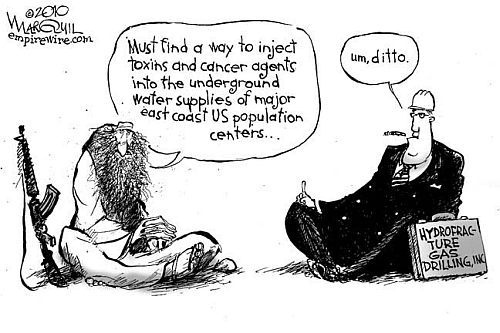
In Ohio, laws that enabled local communities to enforce zoning of oil-and-gas activities were systematically stripped during the 2000s and 2010s. Language snuck into one 2001 Ohio budget bill exempted the oil-and-gas industry from having to disclose safety information to fire departments and first responders.
“A truck carrying brine for injection is the worst of the worst,” says Caggiano. “And it is going through your freeways, through your neighborhoods, through your streets, past your homes, past your schools, and the drivers are not trained in how to handle hazardous waste and don’t have to have a single piece of paper telling a fire chief like me what the hell they are carrying — it scares the fuck out of me.”

Siri Lawson became ill after brine was spread on the road near her home in rural Pennsylvania. Photograph by George Etheredge for Rolling Stone
In the summer of 2017, Siri Lawson noticed a group of Amish girls walking down the side of a dirt road near the horse farm where she lives with her husband in Farmington Township, Pennsylvania. The girls, dressed in aprons and blue bonnets, had taken off their shoes and were walking barefoot. Lawson was horrified. She knew the road had been freshly laced with brine.
Radioactive oil-and-gas waste is purposely spread on roadways around the country. The industry pawns off brine — offering it for free — on rural townships that use the salty solution as a winter de-icer and, in the summertime, as a dust tamper on unpaved roads.
Brine-spreading is legal in 13 states, including the Dakotas, Colorado, much of the Upper Midwest, northern Appalachia, and New York. In 2016 alone, 11 million gallons of oil-field brine were spread on roads in Pennsylvania, and 96 percent was spread in townships in the state’s remote northwestern corner, where Lawson lives. Much of the brine is spread for dust control in summer, when contractors pick up the waste directly at the wellhead, says Lawson, then head to Farmington to douse roads. On a single day in August 2017, 15,300 gallons of brine were reportedly spread.
“After Lindell Road got brined, I had a violent response,” reads Lawson’s comments in a 2017 lawsuit she brought against the state. “For nearly 10 days, especially when I got near the road, I reacted with excruciating eye, nose, and lung burning. My tongue swelled to the point my teeth left indentations. My sinus reacted with a profound overgrowth of polyps, actually preventing nose breathing.”
[When filming Encana dumping their waste on foodland near Rosebud (some of the photos below), one of the truckers spun around off track intentionally, spreading the waste immediately upwind of where Ernst was standing outside her vehicle with her dog Magic (a small Border-Jack rescue), inside with the door open, spraying Ernst, camera gear, truck and Magic (Ernst always filmed upwind of Encana’s reeking waste dumping, expecting it to be toxic and radioactive). The stench was vile. It Hell had a smell, this would be it.
Ernst suffered the same health reactions, excruciatingly painful burns to eyes, skin, throat, tongue, lungs, sinuses, nostrils, mouth, for three weeks afterwards. Magic became suddenly extremely ill, vomiting many times a day and night until he died less than year later. Many times during Encana’s waste dumping in her community, Ernst’s tongue would swell painfully and massively to not just her teeth leaving indentations, but to where she could not close her mouth, making speaking challenging. Her teeth and gums often ached to where it was difficult to chew. During Encana’s frac boom at Rosebud, Ernst was often unable to breath through her nose, suffered pounding sinus aches that vanished when Ernst was away from home.]
The oil-and-gas industry has “found a legal way to dispose of waste,” says Lawson, 65, who worked as a horse trainer but is no longer able to ride professionally because of her illnesses. Sitting in her dining room, surrounded by pictures she has taken to document the contamination — brine running down the side of a road, an Amish woman lifting her dress to avoid being sprayed — she tells me the brine is spread regularly on roads that abut cornfields, cow pastures, and trees tapped for maple syrup sold at a local farmer’s market.
“There is nothing to remediate it with,” says Avner Vengosh, a Duke University geochemist. “The high radioactivity in the soil at some of these sites will stay forever.” Radium-226 has a half-life of 1,600 years. The level of uptake into agricultural crops grown in contaminated soil is unknown because it hasn’t been adequately studied.
“Not much research has been done on this,” says Bill Burgos, an environmental engineer at Penn State who co-authored a bombshell 2018 paper in Environmental Science & Technology that examined the health effects of applying oil-field brine to roads. Regulators defend the practice by pointing out that only brine from conventional wells is spread on roads, as opposed to fracked wells.
But conventional-well brine can be every bit as radioactive, and Burgos’ paper found it contained not just radium, but cadmium, benzene, and arsenic, all known human carcinogens, along with lead, which can cause kidney and brain damage.
And because it attaches to dust, the radium “can be resuspended by car movement and be inhaled by the public,” Resnikoff wrote in a 2015 report. Research also shows that using brine to suppress dust is not only dangerous but pointless. “There appears to be a complete lack of data indicating the practice is effective,” reads a 2018 paper published in the European Scientific Journal. In fact, it notes, the practice is “likely counterproductive for dust control.”
As Lawson puts it, “It is a complete fucking myth that this works. After brine, the roads are dustier.”
But the new buzzword in the oil-and-gas industry is “beneficial use” — transforming oil-and-gas waste into commercial products, like pool salts and home de-icers.
In June 2017, an official with the Ohio Department of Natural Resources entered a Lowe’s Home Center in Akron and purchased a turquoise jug of a liquid de-icer called AquaSalina, which is made with brine from conventional wells. Used for home patios, sidewalks, and driveways — “Safe for Environment & Pets,” the label touts — AquaSalina was found by a state lab to contain radium at levels as high as 2,491 picocuries per liter. Stolz, the Duquesne scientist, also had the product tested and found radium levels registered about 1,140 picocuries per liter.
“AquaSalina is 400-million-year-old ancient seawater from the Silurian Age” that “contains a perfect natural balance of chlorides uniquely suited for snow and ice management,” Dave Mansbery, owner of Duck Creek Energy, the Ohio-based company that produces AquaSalina, tells Rolling Stone. “We recycle and repurpose this natural water to a higher purpose.” He told regional news station WKRC that he soaked his sore feet in AquaSalina.
Mansbery said that he tested for heavy metals and saw “no red flags.” Asked if he tested for radioactive elements, he stated, “We test as required by the state law and regulatory agencies.”
“Every time you put this solution onto your front steps you are basically causing a small radioactive spill,” says Vengosh, the geochemist, who has examined AquaSalina. “If you use it in the same place again and again, eventually you will have a buildup of radioactivity in the sediment and soil and create an ecological dead zone.” But Ohio’s Department of Health concluded AquaSalina poses a “negligible radiological health and safety risk.”
“Reading their study shows it’s about equal to eating a banana a week,” says Mansbery. “Sorry, AquaSalina does not fit the narrative sought by many haters of the oil-and-gas industry.”
CPI Road Solutions, an Indianapolis-based snow-and ice-management company, sells hundreds of thousands of gallons of AquaSalina each winter to the Pennsylvania Turnpike Commission and Ohio Department of Transportation, says Jay Wallerstein, a company VP. Supporters tout that the product has been approved by Pacific Northwest Snowfighters, the nation’s most-respected organization for evaluating de-icing products. But Snowfighters official Jay Wells says, “PNS has not tested AquaSalina for radioactive elements” and that “radium-226 is not a standard test for de-icing products.”
Meanwhile, Ohio is pushing forward with legislation to protect the practice of brine-spreading.
State Senate Bill 165 would slash environmental safeguards and make it easier for products like AquaSalina to be developed. In Pennsylvania, Lawson’s case had led the state’s DEP to acknowledge brine-spreading violated environmental laws, and the practice was halted last year. But Pennsylvania House Bill 1635 and Senate Bill 790 unsuccessfully tried to greenlight brine-spreading again, and even restrict the DEP’s ability to test products. In October, the state Senate passed the bill without debate; its fate remains up in the air in the state’s House of Representatives.
On a sunny day in September 2018, I meet with Kerri Bond and her sister, Jodi, at an injection well next to a shopping plaza in Guernsey County, Ohio. As people dine on fast food and shop for the latest iPhone, trucks unload brine into giant tanks where it will wait to be shot back into the earth. The sisters, both nurses, had grown up wandering the region’s woods and creeks. “We thought it was Shangri-la,” says Kerri. In 2012, a leasing company held a meeting at a church in town, she recalls. “They told everyone they were going to be millionaires. People were high-fiving.” Residents signed documents enabling the Denver-based energy company Antero Resources to begin fracking on their land. As with many people who live near fracking operations, which involve storing and mixing toxic chemicals plus a torrent of carcinogenic emissions when drilling begins, Kerri and Jodi quickly started to notice problems.

“A truck carrying brine for injection is the worst,” says Ohio fire chief Silverio Caggiano. “Drivers don’t have to have a single piece of paper telling me what they are carrying. It scares the f— out of me.” Photograph by George Etheredge for Rolling Stone
Animals on Kerri’s farm dropped dead — two cats, six chickens, and a rooster. A sheep birthed babies with the heads fused together. Trees were dying. One evening Kerri was watching a show about Chernobyl’s radioactive forests, and she felt like she recognized Ohio. She bought a hand-held radiation detector on Amazon and recorded radiation three to seven times the normal level for southeastern Ohio in her backyard, she says. In 2016, an Ohio Department of Health official visited and said not to worry as long as people weren’t exposed to these levels on a regular basis, she recalls. “Hey, dude,” Bond told him, “we are living here.”
Ohio, because of its geology, favorable regulations, and nearness to drilling hot spots in the Marcellus, has become a preferred location for injection wells. Pennsylvania has about a dozen wells; West Virginia has just over 50. Ohio has 225. About 95 percent of brine was disposed of through injection as of 2014. Government scientists have increasingly linked the practice to earthquakes, and the public has become more and more suspicious of the sites. Still, the relentless waste stream means new permits are issued all the time, and the industry is also hauling brine to treatment plants that attempt to remove the toxic and radioactive elements so the liquid can be used to frack new wells.
In Ohio, no public meetings precede the construction of these treatment facilities, many locals remain unaware they exist, and the Ohio Department of Health does not regularly monitor them. They are under the exclusive oversight of the Ohio Department of Natural Resources.
To store radioactive waste, or recycle, treat, process, or dispose of brine and drill cuttings, companies simply submit an application that is reviewed by the chief of the ODNR. They’re called “Chief’s Order” facilities, and Ohio has authorized 46 of them. Companies have to submit a radiation protection plan as part of the application, and ODNR spokesman Steve Irwin says all facilities are inspected regularly. But worker protections and knowledge of the risks still seem to be lacking.
In 2014, at a now-defunct Ohio company operating under Chief’s Order, EnviroClean Services, inspectors discovered a staff clueless of basic radiation safety, operating without protective gear, with no records or documentation for the waste they were receiving, and no instrument to measure it except a pocket Geiger counter that appeared to have never been used. One entry on the form documenting the inspection asks for an “Evaluation of individuals’ understanding of radiation safety procedures.” The inspector noted: “Unable to evaluate — no radiation safety procedures being used.”
Last April, I met with an oil-and-gas waste-treatment-plant operator at a restaurant beside a dusty truck stop in the panhandle of West Virginia. Cody Salisbury left Las Vegas as a teenager and bartended his way across the country before ending up in the Texas oil fields, he says, chowing down barbecue wings as we talk in a quiet corner booth, his phone buzzing repeatedly. “It comes as a sludge, a nasty mess, and we separate the solids, the oil, and the water,” says Salisbury, not divulging other treatment details but alluding to a secret sauce. He is upgrading a waste plant and has helped build two others in Ohio. The opening of one, just a few hundred feet from a nursing home, was attended by Ohio Sen. Rob Portman, who applauded the “regulatory relief” that made it possible.
Salisbury and all of the workers at his plants wear dosimeter badges, which measure external radiation exposure, and they’ve always registered low numbers, he says. Most oil-and-gas waste facilities in Ohio issue dosimeters to their workers, says an ODNR representative, and they haven’t observed anyone that’s exceeded the annual occupational-exposure limit. But dosimeters, says Kaltofen, the nuclear-forensics scientist, don’t register alpha particles — the type of radiation emitted by radium — and aren’t able to track what a person may have inhaled or ingested. So they aren’t providing insight into the key exposures these workers are likely incurring.
“These guys are so proud of their jobs,” says Weatherington-Rice, the Ohio-based scientist, “and they’re working with this stuff and they go home and they’ve got this on their clothes — they can end up contaminating their family as well. This is how this stuff works.”
I ask Salisbury if he and the workers have to wear radiation protective gear, and he shakes his head: “There’s not enough radioactivity in it — I ain’t never seen anyone wearing a respirator.” When asked if he is concerned about radon, he says he has never heard anything about it. “There’s more radioactivity coming off a cigarette, a banana, a granite countertop,” he says.
Even at facilities touted to be the best of the best, there still could be risks. Peter, the Ohio brine hauler, tells me about the Clearwater plant in West Virginia, a $300 million fracking-waste treatment facility completed in 2018 and run by a partnership between Antero and the French water- and waste-management company Veolia. Kevin Ellis, an Antero vice president, described the facility as the “best project like this in the world. Bar none. Period.”
The plant was abruptly “idled” in September after less than two years of operation because of a steep drop in gas prices. One day last year, before it closed, Peter and I drove out toward the hulking facility. As we approached, I saw thick plumes of whitish-gray steam rising out of a series of cooling towers. An engineering report the plant filed with the state showed emissions from treatment tanks were being vented to the atmosphere, after first being routed to a thermal oxidizer, a piece of equipment that can destroy hazardous pollutants — but not radon, says Resnikoff.
Neither Veolia nor Antero replied to questions on whether they were testing the steam for radioactivity. When asked if the agency was monitoring for such things, West Virginia Department of Environmental Protection official Casey Korbini said, “The WVDEP permits are in accordance with federal and state air-quality statutes, and radionuclides are not a regulated pollutant under these statutes.” He added, “This does not mean that radionuclides are prohibited; they are simply not regulated.”
“Son of a bitch, he’s loaded,” says Jack Kruell on a rainy evening this past spring. Kruell, a 59-year-old contractor, is watching a dump truck headed toward Pennsylvania’s Westmoreland Sanitary Landfill, just down the road from his home in Belle Vernon, about 25 miles from Pittsburgh. It’s been accepting fracking waste since 2010.
The end of the line for much of the radioactive solid waste produced from extraction, like drill cuttings and the sludge filtered out of brine, is the local dump. Kruell used to keep a pair of Geiger counters on the spice rack in his kitchen to monitor the regularly above-normal levels.
There are facilities that treat drill cuttings and sludges, “downblending” them with less-radioactive waste to obtain a brew with a radiation content low enough to be accepted at regional landfills. Otherwise, they have to be sent to a low-level radioactivity waste site out in Utah, says Troy Mazur, a radiation safety officer I speak to from Austin Master Services, a downblending facility in Martin’s Ferry, Ohio. “I would not like to divulge too much about our process internally,” says Mazur. “There is waste that comes in that goes directly to a low-level radioactivity site,” he says. “It is all based on an economic decision.”

Pennsylvania resident Jack Kruell kept a pair of Geiger counters on his spice rack to monitor the radioactivity from a dump near his home outside Pittsburgh. Photograph by George Etheredge for Rolling Stone
A 2013 report co-authored by Resnikoff calculated that sending solid oil-and-gas waste like drill cuttings to a low-level radioactive-waste facility could mean as much as a 100-fold increase in cost, so there’s an incentive for companies to get the waste into a regional landfill.
A letter from a whistle-blowing employee of Westmoreland to one of Kruell’s neighbors last April told of “numerous overlooked DEP violations” and “dumping of frackwater material and sludge in excess of legal limits.”
The company “is getting away with everything that they can,” the letter said. “I am writing to you because I know your quality of life is being affected and I don’t want you to get a raw deal.” The Westmoreland Sanitary Landfill did not reply to questions from Rolling Stone.
But what worries Kruell most is a metallic dust he has noticed speckling his bushes and grass, and the pain he gets when he mows his lawn. “The day after I cut the grass, I have pain in my bones so bad I can’t move,” says Kruell. “Like someone taking a drill bit and drilling into your bone without anesthetic.” [Living in Encana’s frac field, Ernst developed similar excruciating body pain rendering her incapable of moving some days. Many trees on her property died. Ernst thought the pain was caused by aging and stress of her lawsuit and Canada’s dirty judges.]
“These are the people who I worry about most,” says Weatherington-Rice, because metals like radium can easily become airborne with small clay particles in dust. “You put it up on top of the landfill and put a wind over it, what do you think is going to happen?” she says. “Radioactive metals and other heavy metals are going to settle out over communities and people downwind. They are all hazardous, and they will all kill you eventually if you get enough of them in you.”
There are at least five landfills in West Virginia that accept drill cuttings, at least five in New York, 10 in Ohio, and 25 in Pennsylvania. Most of the drill cuttings are from fracking and can be radioactive. “We have never knowingly buried very large quantities of known low-level radioactive waste in a generic, municipal solid-waste landfill originally designed for household garbage,” Bill Hughes, an industrial electrician who served 15 years on a board overseeing the municipal landfill in West Virginia’s Wetzel County, wrote to the West Virginia Department of Environmental Protection. The dangers involved, he said, “might not be known for generations.” In 2018, when I met Hughes, who is now deceased, he told me the issue of dealing with the industry’s radioactive drill cuttings “blindsided” state agencies. “They really weren’t sure how to regulate this,” he said.
The foul discharge of water passing through Westmoreland, called “leachate,” flowed downhill through a sewer pipe and into the Belle Vernon sewage-treatment plant, where superintendent Guy Kruppa says it was killing the microbes needed to digest the sewage. His facility has no ability to remove the radioactivity, he says. This means, as long as his plant was receiving the contaminated leachate, insufficiently treated sewage and radioactivity was being spewed into the Monongahela River, which runs through downtown Pittsburgh.
“What this place is, essentially, is a permit to pollute,” says Kruppa. “It’s a free pass to go ahead and dump it in the river, because we don’t test for that stuff, we don’t have to. It’s a loophole. They found a way to take waste that no one else will take to the landfill and get rid of it in liquid form. Essentially, we are the asshole of the fracking industry.”
Kruppa tried for months to make the Pennsylvania DEP act on the dilemma, but to no avail. “DEP has no evidence…that would indicate levels of heavy metals or radioactive elements in leachate,” says spokeswoman Lauren Fraley. The agency is not worried about the leachate entering Pennsylvania rivers. She says the DEP concluded there was “no immediate or significant harm to human health or the environment, given the enormous volume of water in the receiving river.”
But in May, a county judge ordered the landfill to stop sending the sewage plant its leachate.
And there are risks even when there’s a large body of water to dilute the contamination: A 2018 study found that in Pennsylvania’s Allegheny River, oil-and-gas waste was accumulating in the shells of freshwater mussels.
“We are putting things in the river and don’t know what we’re doing, and we might be putting people at risk,” says Kruppa. “At times it seems like I am the only one not playing ball here, and everyone else, including the DEP, is turning their heads and telling us there’s no problem.”
Despite dire climate warnings, the U.S. oil-and-gas industry is in the midst of an epic boom, what a 2018 Department of Energy paper calls an “oil-and-gas production renaissance.” Pipelines, power plants, and shipping terminals are being developed across the nation at a dizzying pace.
But in the excitement of this boom there is little mention of the pipes, pumps, and filters in these plants that will become coated with radioactivity. Or of the fountain of radioactive brine and drill cuttings spewing forth from wells. Or of the workers being exposed, the land being contaminated.
“One question I ask these companies,” says Smith, the New Orleans lawyer, “‘What have you done to go out and find all the radioactive waste you have dumped all over the United States for the past 120 years?’ And the answer is nothing.”
A 2016 lawsuit by environmental groups forced the EPA to reassess its monitoring of oil-and-gas waste, which it had not done since before the fracking boom. But in 2019 the agency concluded “revisions…are not necessary at this time.”
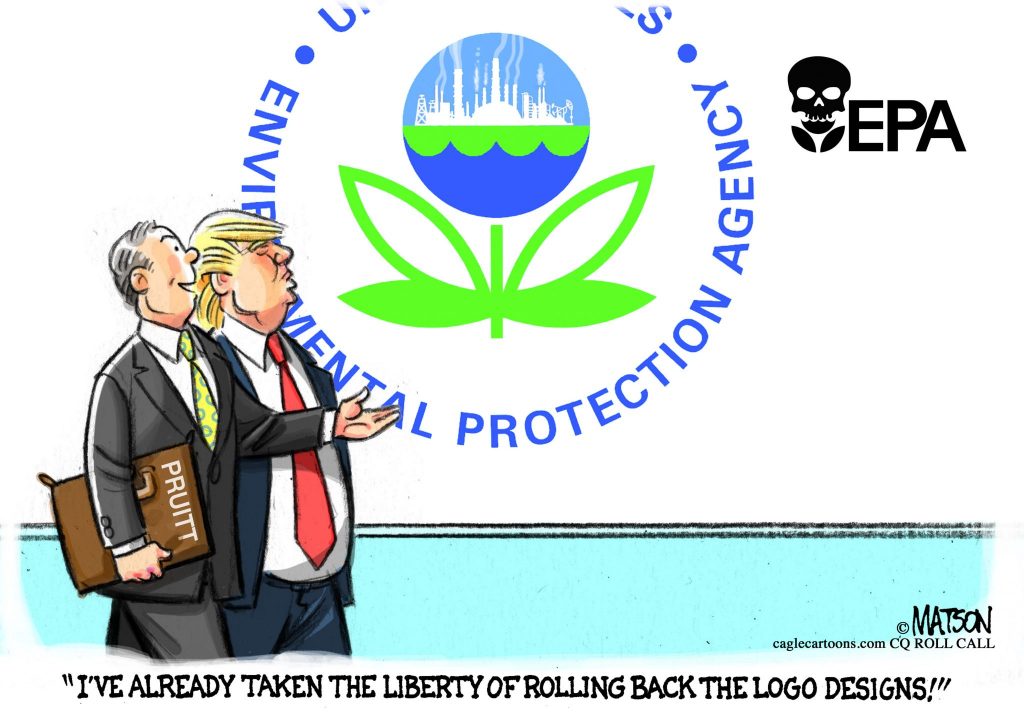
When I checked in with Peter around the holidays he had collected a new batch of samples and said anxiety levels among brine haulers were at an all-time high. “The other drivers are getting scared,” he says. “Guys are wanting to get tested.”
“The workers are going to be the canaries,” says Raina Rippel of the Southwest Pennsylvania Environmental Health Project, a nonprofit public-health organization that supports residents impacted by fracking. “The radioactivity issue is not something we have adequately unpacked. Our elected leaders and public-health officials don’t have the knowledge to convey we are safe.”
But knowledge is out there. Radium can be detected in urine; a breath test can pick up radon. Because radium builds up in bone, even a body buried in a cemetery could convey details of someone’s exposure, says Wilma Subra, a Louisiana toxicologist who first started tracking oil-and-gas radioactivity in the 1970s.
“There is a massive liability that has been lying silently below the surface for all these years,” says Allan Kanner, one of the nation’s foremost environmental class-action lawyers, whose recent cases have included PFAS contamination and the Deepwater Horizon oil spill. “The pieces haven’t all really been put together, because the industry has not really been telling the story and regulators haven’t been telling the story and local doctors aren’t informed, but at some point I expect you will see appropriate and reasonable litigation emerge on this.”
If so, it could have a devastating impact on the fossil-fuel industry, especially if tighter regulations were put in place and oil-and-gas waste was no longer exempted by the EPA from being defined as hazardous waste.
“The critical component of the profit margin for these companies is that they can get rid of the waste so cheaply,” says Auch of FracTracker Alliance. “If they ever had to pay fair-market value, they wouldn’t be able to exist.”
“It has been argued,” says Liz Moran, with the New York Public Interest Research Group, “that if you close the loophole, you would put the industry out of business.” When asked what would happen to the industry if the EPA exemption were removed, University of Cincinnati legal scholar Jim O’Reilly, author of 53 textbooks on energy development and other topics, replied with a single word: “Disaster.”
Radioactivity “is the way into the Death Star,” says Melissa Troutman, an analyst with the environmental group Earthworks. The industry is afraid of two things, she says, “losing money, and losing their social license.” The high cost of drilling relies on a continual infusion of capital, and “the number of operational risks and bottlenecks continues to grow,” states a 2018 article by the energy consultancy group Wood Mackenzie. But while the industry is continuously supported by Wall Street cash, social license may be a more difficult coffer to refill.
Paul Templet, the former secretary of the Louisiana Department of Environmental Quality and the first state official to tackle oil’s radioactivity issue, is now 79 years old and lives with his wife in an adobe house in New Mexico. But he has to return to Louisiana once every couple of months to serve as an expert in lawsuits over oil-field contamination.
In recent years, a growing group of landowners has discovered that the oil-and-gas wells that brought them riches also tarnished their property with heavy metals and radioactivity. “Almost everywhere we test we find contamination,” says Templet.
There are now more than 350 of these legacy lawsuits moving forward in the state. Proceedings are sealed, and it is difficult to tally sums across all cases, but Templet says it’s fair to say that what began as a little nibble on the industry’s pocketbook has turned into a forceful tug. “They’ve known for 110 years, but they haven’t done anything about it,” says Templet. “It’s the secret of the century.”
Refer also to:
Slick Water: The Devil is in the Details
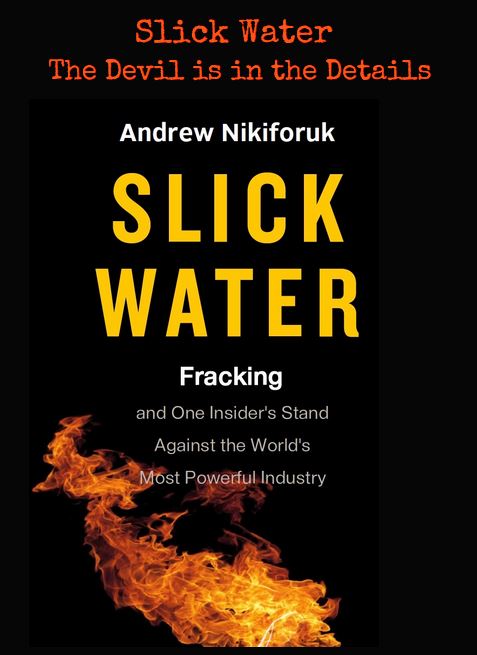
Refer also to some photos showing oil and gas drilling waste intentionally dumped by companies in Alberta on public roads and foodlands:
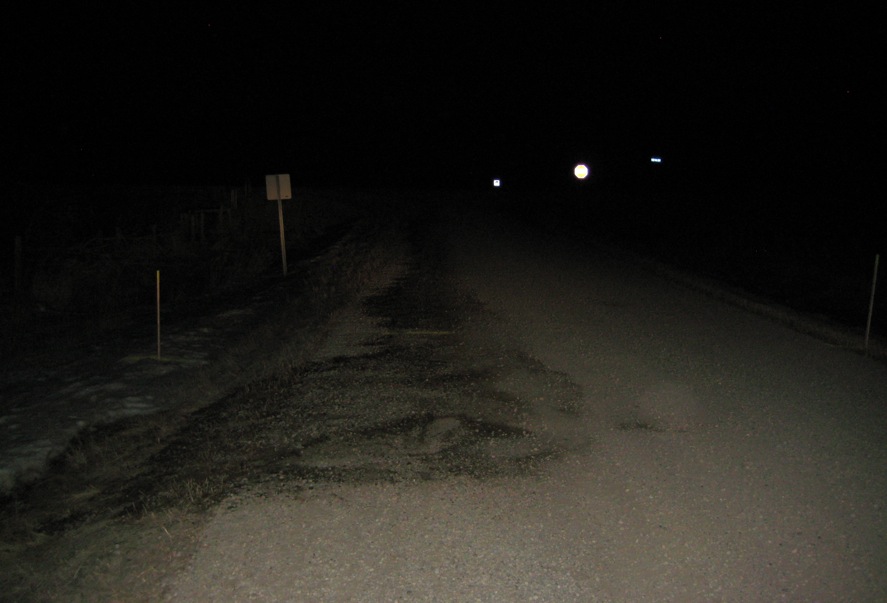
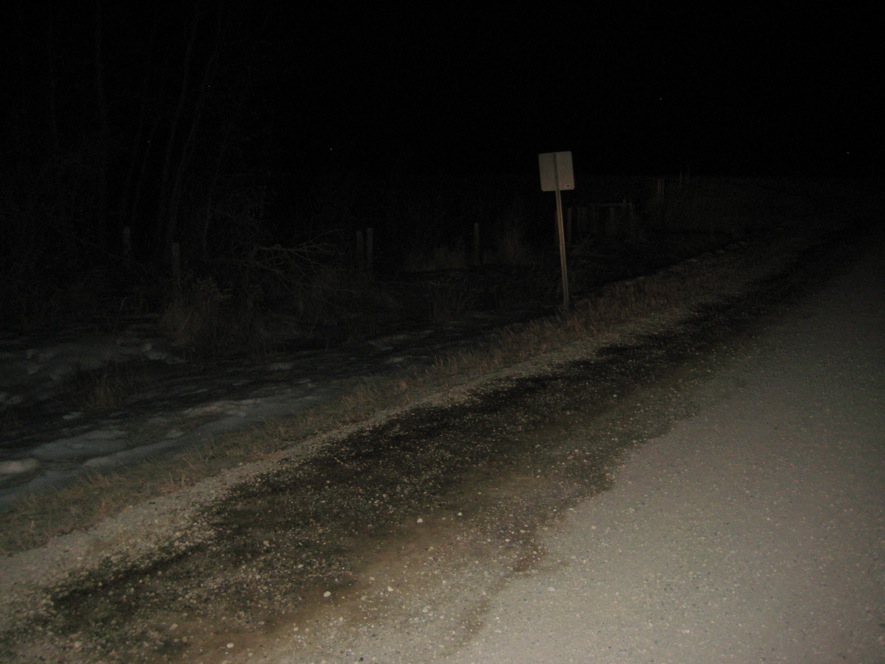
On a public road in the Lochend, about half an hour NW of Calgary. The waste reeked. The “regulator” refused to investigate.
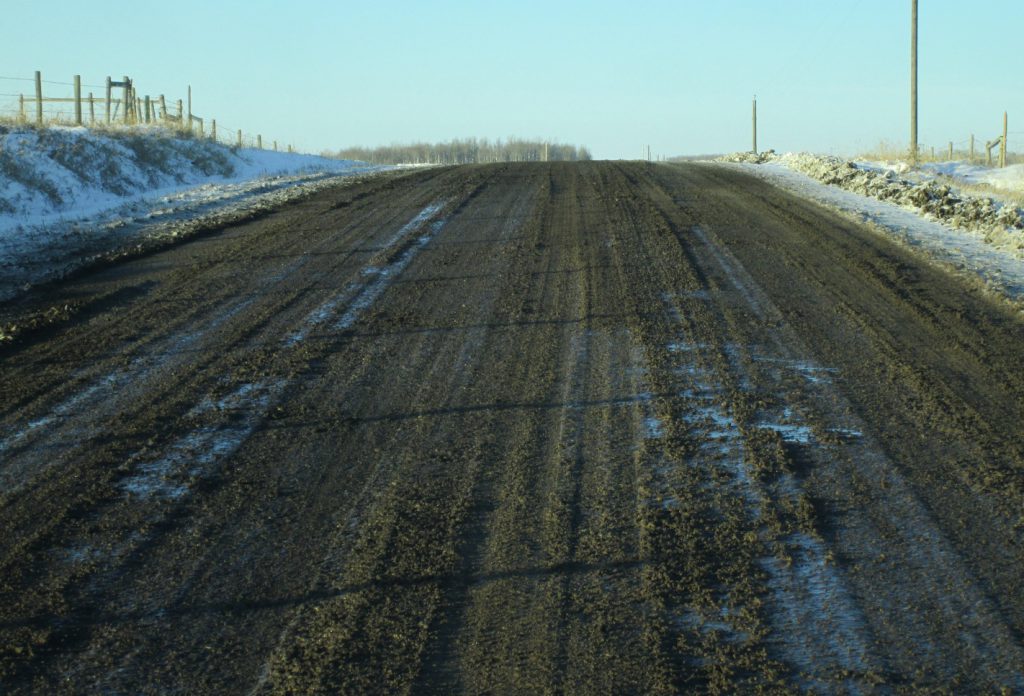
On public road about half and hour NW of Calgary
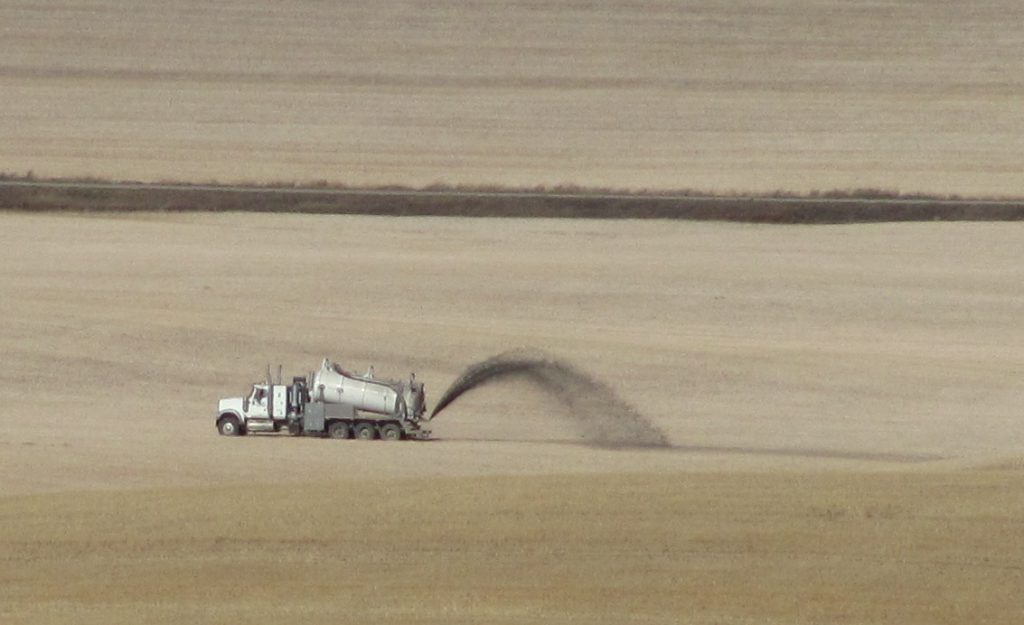
About a mile west of Rosebud and Ernst’s home, Encana dumping its waste on foodland in 2011. It was a terribly windy day, the waste spray could be seen carried far in the wind. Residents, including children, were leaving church in the Hamlet of Rosebud.
What toxic radioactive substances were they breathing?

Strips of Encana’s waste dumped in 2011 on foodland just west of Rosebud
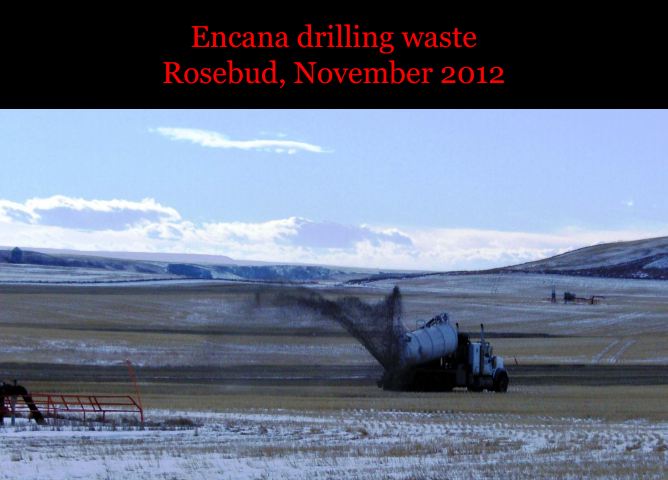


Encana dumping its waste in 2012 on the same cropland as in 2011
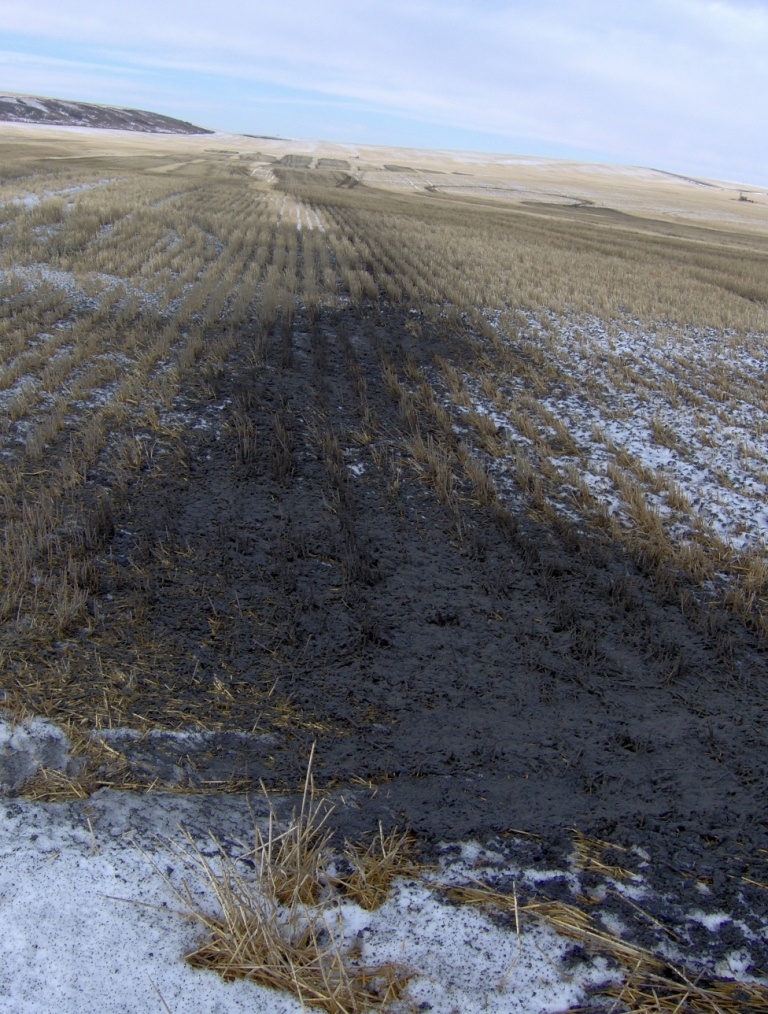
This waste reeked, and burned nostrils, eyes, mouth and throat of the person filming.

Waste dumping on foodland in the Lochend in 2013
What are we breathing, eating and drinking and walking on with our loved ones?
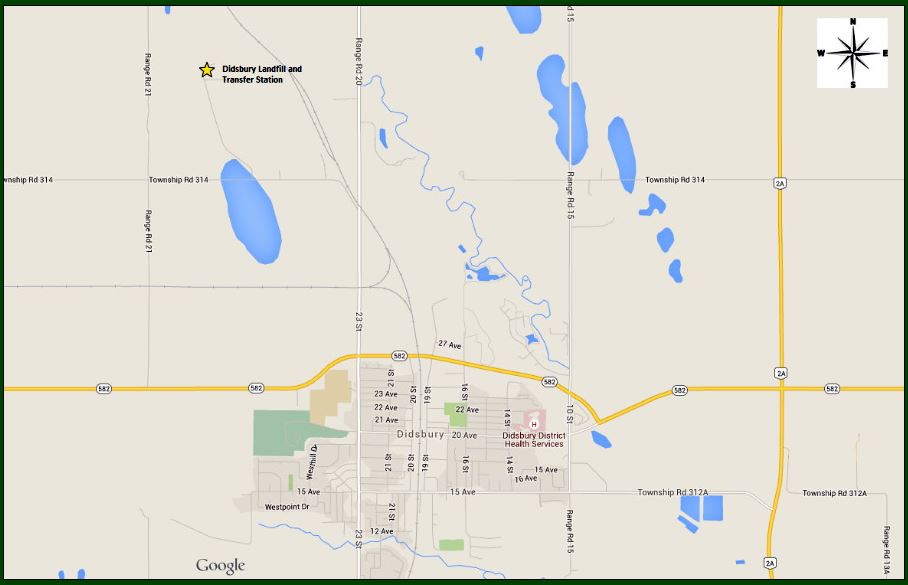

Hauling oilfield’s toxic waste to pile near Didsbury, damaging public roads
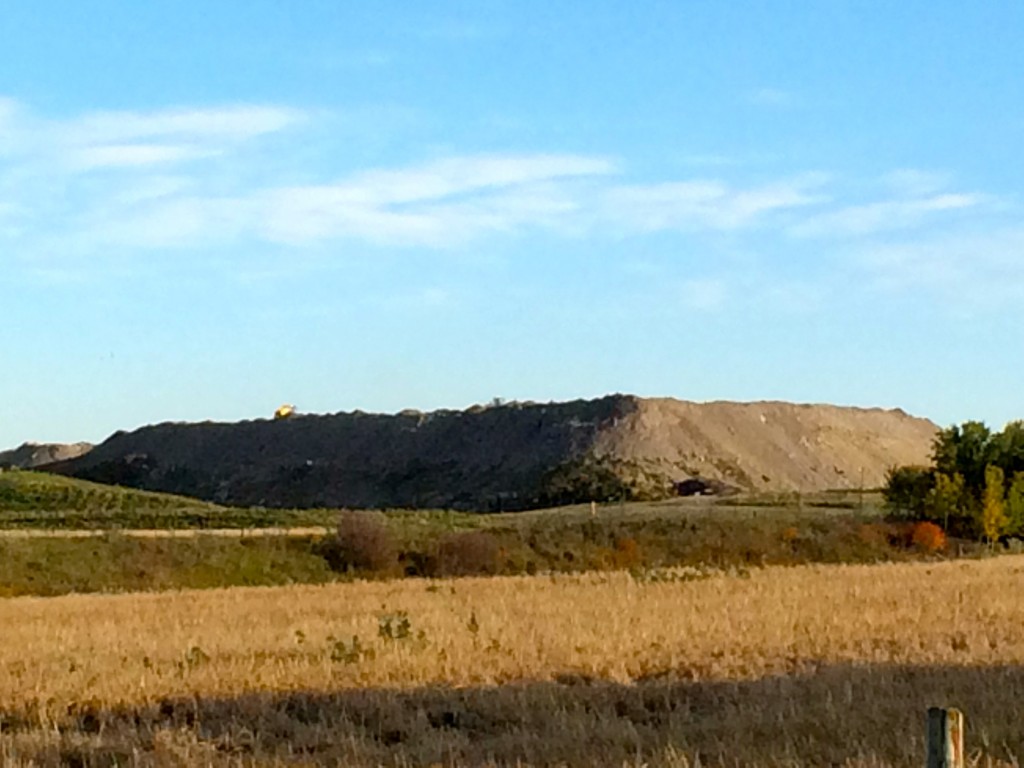

Didsbury’s proud pile of the oil and gas industry’s toxic, likely radioactive waste. What are you and your loved ones breathing when the wind blows?
How many farms and private homes has the industry contaminated with hot waste and pipes?
